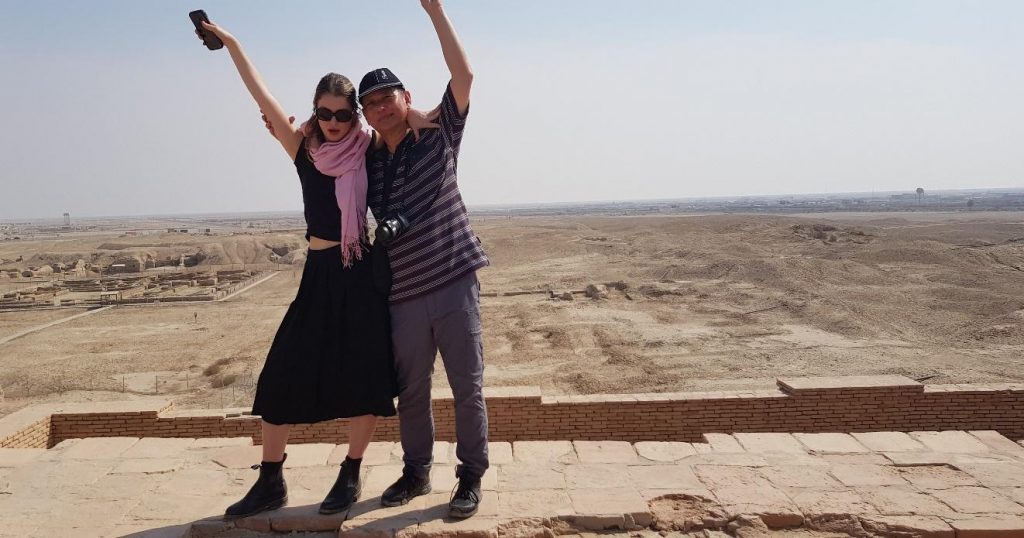By Andy Khong

Nasiriyah, where Ziggurat of Ur is located
“A ziggurat is a work of monumental architecture rising in steps to a flat platform and topped by a temple. The structure emerged in ancient Mesopotamia for use in religious rituals.” (www.worldhistory.org)
The word itself comes from the Akkadian language which means height or pinnacle. It is a religious and architectural structure of major cities in Mesopotamia from around 2500 to 500 BCE. Mesopotamia is a Greek word which means “land between two rivers”, being the land surrounded by the Tigris and Euphrates rivers. Present day Iraq and Syria is about the approximate site of ancient Mesopotamia.
What is a ziggurat?
The Sumerians, one of the earliest known civilizations from southern Mesopotamia were responsible for their earliest construction. The Akkadians from northern Mesopotamia eventually conquered the Sumerians, and carried on the practice of ziggurat construction. Other civilizations that settled in Mesopotamia like the Assyrians, and Babylonians also built these strcutures.

Tell al-Muqayyar, Iraq. A temple dedicated to the Moon God Nanna, the patron deity of Ur.
A ziggurat is a massive structure in the form of a pyramidal tower with a rectangular base, built in successive stages with a number of stories or terraces (usually 2 to 7), outside staircases, and a temple/shrine at the top. The legendary Towel of Babel mentioned in Book of Genesis (Bible) is built as a ziggurat. Sloping sides and terraces of ziggurats were usually landscaped with trees, plants, and shrubs e.g. the Hanging Gardens of Babylon. During the ancient times, people believed that Gods lived in the sky and the top of the ziggurat is where Priests could commune with a patron deity on behalf of the people by holding religious ceremonies. Each ancient city would have a different patron deity.
Is there a difference between pyramids and ziggurats? Pyramids were built outside cities as tombs for Pharaohs or Kings in ancient Egypt and Central America. Ziggurats were built in ancient Mesopotamian cities as a temple used by the community. Pyramids have narrow chambers to access inner tombs, whereas Ziggurats are solid with no inner chambers. Pyramids are built with a triangular capstone at top; Ziggurats are built with steps and/or terraces on its sides, multi-storied, and are flat at the highest level with a temple/shrine dedicated to the patron deity of the city.
Today about 25 ziggurats remain with the best-preserved ziggurat located at Ur. The ancient city of Ur (known as Tell al-Muqayyar today) is located near the city of Nasiriyah [360 km (225 miles) south-east of Baghdad], Dhi Qar Province, Iraq. The Ziggurat at Ur was built around 2100 BCE by King Ur-Nammu and was completed by his son King Shulgi. It was built as an administrative centre, and as a temple dedicated to the Moon God Nanna, the patron deity of the ancient city of Ur. The Ziggurat at Ur has been restored twice – by Babylonian King Nabodinus in the 6th century BCE, and by Iraqi dictator Saddam Hussein in the 1980ies.
Adjacent to the the structure archaeologist believe that a complex dating around 1900 BCE was Abraham’s (Ibrahim in Arabic) house. The Bible mentioned that Abraham was born in Ur Kasdim, a city commonly translated as “Ur of the Chaldeans”. Mainstream scholarly opinion agree that the location of Biblical Ur Kasdim (Ur of the Chaldeans) is the city of Ur (Tell al-Muqayyar today). In March 2021, Pope Francis conducted an inter-religious prayer service in Ur as he drew renewed attention to a place revered as the birthplace of Abraham, the patriarch of Jewish, Christian, and Muslim faiths.

Abraham’s House, Ur. Abraham lived here for 70 years before moving to Haran, then to Canaan when he was 75 years old.

View of Ur

Moon Dancing as a conduit for humanity of Oneness between Universe and Earth.
For details of YPT’s tours to Iraq.





